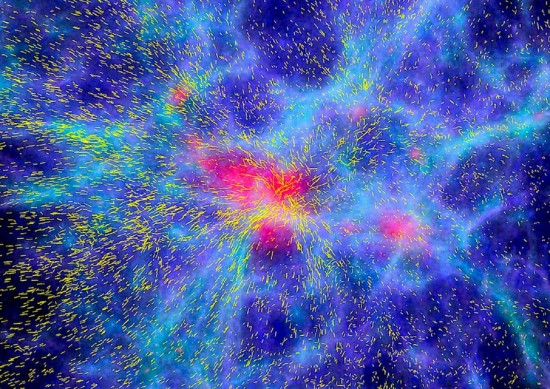Cold dark matter theory might be in need of serious revision.
Dark matter theory makes the news every once in awhile. Although cold dark matter (CDM) gets its name from the idea that it cannot be detected with any known instruments, cosmologists persist in using it to prop up their other ideas about how far away things are, how old they are, and what they are made of. This is done in order to save the prevailing gravitational theory of the Universe.
Since CDM does not emit electromagnetic radiation in any bandwidth from radio to gamma rays, the only possible way to confirm its existence is by using the gravitational theory of the Universe to look for its gravitational effects on so-called “luminous matter.” As was noted in a past Picture of the Day article, galactic rotation is considered anomalous by conventional astronomers, unless CDM is added to a galaxy’s gravitational mass.
This undetectable matter is said to prevent all galaxies from flying apart. The astronomical community has been trying for years to understand why there is a lack of visible material in the Universe. Galaxy clusters, in particular, do not seem to be massive enough to hold together as a group. There is not enough gravity in the visible stars and gas clouds to account for their orbital velocities, as well as the consolidation of individual galaxies into clusters.
According to most physicists, if CDM exists, then it ought to be a particle, since gravity is based on mass attraction. If CDM is holding the stars in their galactic orbits, and pulling those galaxies into clusters, there must be invisible particles causing those effects.
In the recent press release, CDM theory is under scrutiny because some dwarf galaxies don’t conform to the generally accepted way that galaxies evolve. In the past, it was thought that they were primarily composed of CDM, and computer simulations indicated that many of them should form in a large halo around the Milky Way, for instance. However, sky surveys have confirmed that there are far too few dwarf galaxies and they are too large.
One of the “disturbing conclusions” announced by the science team is that CDM might not exist. There might instead be “warm dark matter (WDM)” that formed “minutes after the big bang,” rather than millionths of a second. If that is the case, then instruments like the Large Hadron Collider (LHC) would be useless in trying to detect it. Considering that one of the LHC’s primary goals was the search for CDM, it seems like a rather elementary blunder among theoretical physicists.
(When their galaxy evolution simulations use WDM, the dwarf galaxy halo around the Milky Way conforms to reality.)
Another mysterious galactic phenomenon that requires adherence to the CDM theory are the “filaments” of radio-waves that twist out from the center of our galaxy. They are said to be from colliding dark matter particles. The article hints at an electrical explanation, but then takes its own twisted turn into an explanation involving something that has not been proven and that seems to defy proof:
“…electrons—created when high-energy dark matter particles smash into each other—could be what gives rise to the synchrotron radiation detected here on Earth.”
Despite the observation that the regions possess strong magnetic fields, and that electrons could be involved, electricity is completely missing and dark matter is woven into the explanation as if it were the only way for those observations to make sense.
Filaments of electric current can flow in closed circuits through plasma. It is the existence of electric circuits in space that distinguishes Electric Universe theory from most conventional viewpoints. Phenomena that appear “mysterious” to space scientists are readily explained using observational evidence coupled with the results from laboratory experiments. That fact helps to distinguish Electric Universe concepts from others. Gravity cannot be modeled in the laboratory in the ways that plasma can.
Stephen Smith













